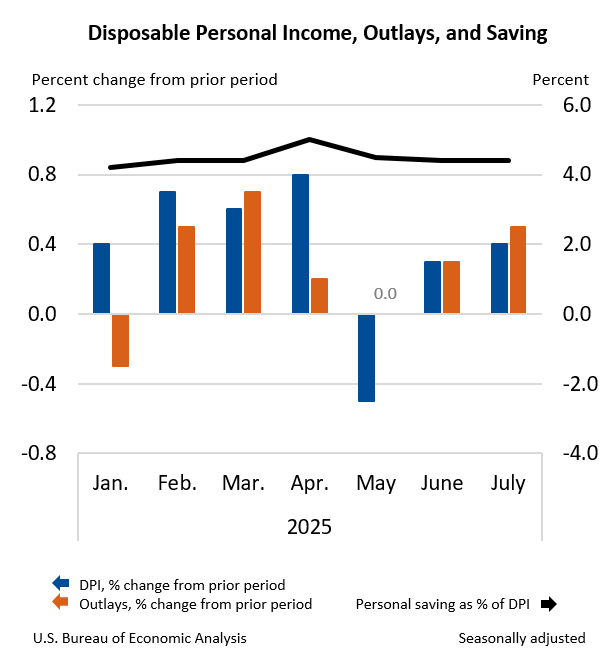Bureau of Economic Analysis
Personal Income and Outlays, July 2025
Personal income increased $112.3 billion (0.4 percent at a monthly rate) in July, according to estimates released today by the U.S. Bureau of Economic Analysis. Disposable personal income (DPI)—personal income less personal current taxes—increased $93.9 billion (0.4 percent) and personal consumption expenditures (PCE) increased $108.9 billion (0.5 percent). Personal outlays—the sum of PCE, personal interest payments, and personal current transfer payments—increased $110.9 billion in July. Personal saving was $985.6 billion in July and the personal saving rate—personal saving as a percentage of disposable personal income—was 4.4 percent.
Principal Federal Economic Indicators
Noteworthy
- 2025 News Release Schedule
- Innovation at BEA
- 2025 Annual Updates
- Distribution of Personal Income Nowcast
- New! Services Trade Data for More Countries
- Data Tool: Trade in Value Added
- Updated: RIMS II Regional Multipliers
- Arts and Culture
- Space Economy
- FDI Now in State BEARFACTS
- Quick Guide: Price Indexes
The Latest
U.S. International Trade in Goods and Services, 2009 annual revision
U.S. Census Bureau U.S. Bureau of Economic Analysis NEWS
Gross Domestic Product for the Commonwealth of the Northern Mariana Islands
CAPITAL HILL, SAIPAN (June 7, 2010) – Today, the Bureau of Economic Analysis (BEA) is releasing its first set of estimates of the major components of gross domestic product (GDP) for the Commonwealth of the Northern Mariana Islands (CNMI).1
Personal Income and Outlays, April 2010
Personal income increased $54.4 billion, or 0.4 percent, and disposable personal income (DPI) increased $57.6 billion, or 0.5 percent, inApril, according to the Bureau of Economic Analysis. Personal consumption expenditures (PCE) increased $4.0 billion, or less than 0.1 percent.
Gross Domestic Product, 1st quarter 2010 (second estimate) | Corporate Profits, 1st quarter 2010 (preliminary estimate)
Real gross domestic product -- the output of goods and services produced by labor and property located in the United States -- increased at an annual rate of 3.0 percent in the first quarter of 2010, (that is, from the fourth quarter to the first quarter), according to the "second" estimate released by the Bureau of Economic Analysis. In the fourth quarter, real GDP had increased 5.6 percent. The GDP estimates released today are based on…
Advance Gross Domestic Product by Industry, 2009
Advance GDP by Industry Statistics for 2009 and Revised Statistics for 1998-2008
Downturns in durable-goods manufacturing and finance and insurance and a continued contraction in construction were the leading contributors to the downturn in U.S. economic growth in 2009, according to preliminary statistics on the breakout of real gross domestic product (GDP) by industry from the Bureau of Economic Analysis. The economic downturn was…
Gross Domestic Product for American Samoa
UTULEI, AMERICAN SAMOA (May 10, 2010) Today, the Bureau of Economic Analysis (BEA) is releasing its first set of estimates of the major components of gross domestic product (GDP) for American Samoa.1
GDP for American Samoa, the Commonwealth of the Northern Mariana Islands, Guam, and the U.S. Virgin Islands
WASHINGTON, D.C. (May 5, 2010) -- The Bureau of Economic Analysis (BEA) released its first set of estimates of gross domestic product (GDP) for American Samoa, the Commonwealth of the Northern Mariana Islands (CNMI), Guam, and the U.S. Virgin Islands (USVI).1




